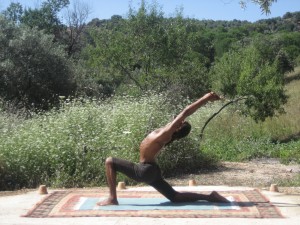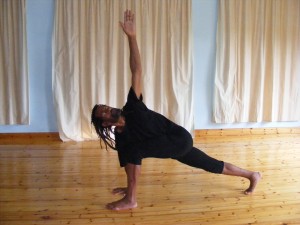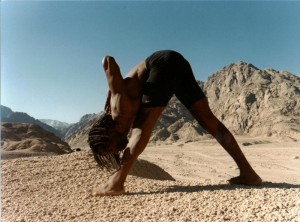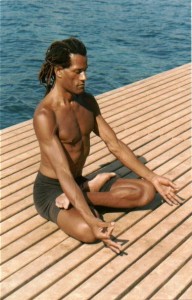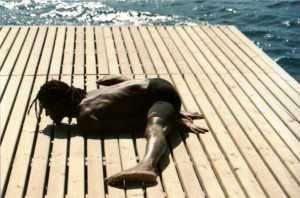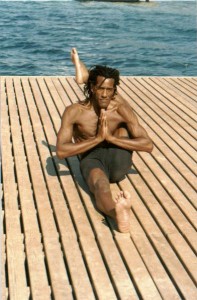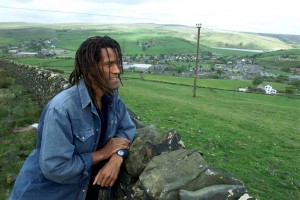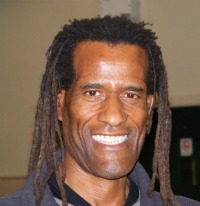 A spiritual journey of discovery and how this practice has changed my life into one of continual investigation into the meaning of life, its purpose, and understanding the nature of things.
A spiritual journey of discovery and how this practice has changed my life into one of continual investigation into the meaning of life, its purpose, and understanding the nature of things.
by Granville Cousins
My first experience with Yoga was at school at the age of sixteen. I remember one of my classmates trying to place the palms of his hands together in between his shoulder blades in the posture of Namaste. He was the only person who could do it and I wondered where he learned something like that. “Yoga” he said. And I never gave it another thought. Coming from an athletic and Catholic background, I was looking for a form of exercise that would stay with me for the whole of my life that also encompassed a spiritual element. In my late teens I again came into the field of yoga when I saw a television program called “Yoga for Health” introduced by Richard Hittleman and assisted by such a notable yoga practitioner as Lynne Marshall. The postures were challenging for me as I felt I possessed no natural flexibility. However my appetite had been whetted so I then pursued my quest on the path of Yoga.
The first major breakthrough came when I practiced from a book called “Yoga and Health” by Selvarajan Yesudian and Elizabeth Haich. I remember the bliss and the ecstasy of my first sessions. One eye on the book while trying to execute the postures and breathing exercises. This made me keener to learn, so I was glad when I came across “Light on Yoga” by Mr. B.K.S. Iyengar. His excellent performance of the postures and in-depth detail contained in the text were very inspiring for me. I used to practice for 3 – 4 hours daily using the tables provided at the back of the book. However after 6 months of this intense practice, I guess I just felt overwhelmed with it all, and went on to investigate Tai Chi, a gentle form of Martial Arts that incorporates meditation in movement. I Stayed with Martial Arts for about 10 years, during which time I achieved a 1st dan (Black – Belt) in Kung Fu and then later studied Aikido.
My appetite for meditation had been whetted from the early times when I was working on the yoga alongside Selvarajan Yesudian’s book when I became acquainted with Buddhism. I attended a 10-day retreat with the Venerable Archarn Sumedho, a monk of immense stature and knowledge in the way of the Buddha. This was very different from what I had been used to, and I felt that this stiff body of mine needed more opening and flexibility if I was going to attend many more of these retreat sessions. I also became involved in Zen Buddhism and by this time I knew that this was more the way that I wanted to go, so after obtaining my 1st dan in Kung Fu I left the Martial arts and in 1982 went up to Throssel Hole Priory, a Zen training monastery, for a 3 month Lay Training Program but was very pleased when they permitted me to stay longer, a total of 6 months in all. This I regard as one of the richest times of my life with regard to training. My role at the monastery was to do with the joinery work, and as that was my trade I put my skills to good use. But monastic training is more about giving yourself to what you are doing in your daily life, which isn’t always what we want to do.
After leaving the monastery I again taken up my trade as a self-employed joiner. I really missed the Yoga Practice though, and I was very glad when a friend of mine introduced me to a yoga teacher in Manchester called Jeanne Maslen, a lady with whom I hold the utmost regard, and from here I felt that I became firmly set on the path of yoga. Whilst in her classes I decided that I wanted to learn more about yoga and to attend an Iyengar Teachers Training Course.
The course was very involved and I obtained my Introductory Level and Intermediate Junior Teacher Training Certificates. I also took up the martial arts again. This time I studied Aikido with Wassel Koleznikov and became one of his assistants in the class. As there were only two assistants we had to show the techniques to the students that had been demonstrated on us by the Sensei (teacher). After four years with Wassel, I again left the martial arts and focused on my Zen training and yoga with a Japanese Zen Master called Hogen. His practice is very inspiring and we used to go running and practice yoga along with the Zazen (seated meditation). This was quite an intense period of my life and on top of all that was going on I started to build my own house. This took about 18 months and after selling it bought Higher Pot Oven Farm, which is where I live now. In 1990 I went with my teacher and other students to Pune in India where we practiced with Mr. Iyengar on a three-week Teachers intensive. This was quite hard going but so rewarding to be in the presence of one of the great Yogis of this modern age. Being in the presence of such a man and in the romantic atmosphere of India made lasting impressions on my life. On my return to England, and having every intention of carrying on with my joinery work, something had changed within me, and the course of my life was to take another turn.
One January morning whilst preparing to get on with my job, after returning back from the Christmas holidays, I was taken aback when I was summoned from within to leave the joinery trade and go and teach yoga. A new direction had been prepared for me, and a new life-style was about to be forged. I went down to the unemployment offices and applied for The Enterprise Allowance Scheme. With their funding, this would allow me to go and teach yoga on a full time basis until I could build up enough classes to make a living. Manchester was where my classes were set up and I had just made inroads into teaching yoga in health clubs. At that time yoga and the leisure industry had opposing views on many aspects of fitness so it was quite something when I was able to set up classes at one of the premier health clubs in the area, ‘Living Well’. After teaching Iyengar Yoga for some years, in 1995 I was introduced to Michael Taylor and Elizabeth Wilson with whom I learnt Ashtanga Vinyasa Yoga at their house on Sunday Mornings. These were some of the most enjoyable yoga sessions that I have attended. In an upper bedroom with about 5 of 6 other yogis, we sweated our way through the Primary Series.
After a short while I was invited to meet a person with whom the yoga world has much to be grateful. This man was Derek Ireland, and I attended one of his Ashtanga Vinyasa Yoga workshops in London. He also accepted my application to teach for him in Crete, at The Practice Place. Together with his partner Radha, I studied with them in the morning sessions and taught Iyengar Yoga in the evenings. Since those early days I have now set up classes teaching mainly Ashtanga Yoga and Posture Classes that are based for the most part around the Primary Series but incorporating my knowledge of the postures gained mainly from my Iyengar Yoga background. My classes are quite thorough, my students tell me, and on my Workshops and Yoga Holidays I introduce meditation practice as part of the daily regime. This is most important, as yoga is very supportive to the discipline of mediation. If we cannot sit still, how can we allow the deeper levels of our consciousness to manifest? I practice the Sound and Light Meditation and my Meditation Master is Suma Ching Hai. The requirements for this path are an Ethical life Style, a Vegetarian diet including no eggs, Abstention from Alcohol and Drugs, and to devote a certain proportion of the day in contemplation of the Holy Sound and Divine Light. “If thine eye be single, thy whole body shall be filled with Light”.
During these times when the planet needs to be treated with respect, I feel that Ecology and working with the environment are crucial issues. Myself I have an Organic Reed-Bed System installed on my farm, which deals with all my Sewage and grey water. In the Summer when the Reeds are blooming, it is really beautiful and looks just like a garden with 4 foot high Norfolk Reeds occupying a portion of the field. There are no chemicals involved, the whole process relying on the natural elements and bacteria living around to roots of the reeds. My farmhouse has just been refurbished with the aid of a council grant and I hope to continue to improve and incorporate environmentally friendly ways towards completion of the development.
May I take this opportunity to thank all my teachers and students, and let us enjoy together the Bliss of the Divine and the Ecstasy of His Grace.
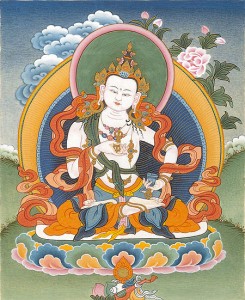 How does washing out your clothes at the laundry and Purification tie into yoga practice. Well it’s pretty easy to make this analogy. As we strive to keep our bodily garments free from pollution so must we make effort to keep our minds free from the pollution of unwholesome thoughts and to try and eradicate them when we find them in our consciousness. If we notice dwelling on thoughts of malice or other kinds of thoughts that we know in our hearts are not profitable then we need to divert our attention towards that which is wholesome and beneficial. Easier said than done eh?
How does washing out your clothes at the laundry and Purification tie into yoga practice. Well it’s pretty easy to make this analogy. As we strive to keep our bodily garments free from pollution so must we make effort to keep our minds free from the pollution of unwholesome thoughts and to try and eradicate them when we find them in our consciousness. If we notice dwelling on thoughts of malice or other kinds of thoughts that we know in our hearts are not profitable then we need to divert our attention towards that which is wholesome and beneficial. Easier said than done eh?

